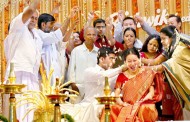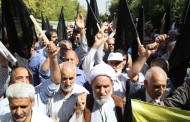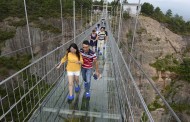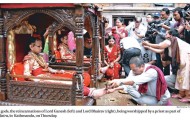Prime Minister Narendra Modi spoke at the Silicon Valley during his second visit to the US. This marked the first time an Indian prime minister has visited the IT and technology hub in thirty years.
Modi met with the who’s who of the technology world, including Google’s Sundar Pichai, Microsoft’s Satya Nadella, Apple’s Tim Cook, Qualcomm’s Paul Jacobs, Adobe’s Shantanu Narayen.
Here’s are a few quotes from Modi’s speech at Silicon Valley that show just how in-sync he is with new technology and the times.
And, I know to achieve the vision of Digital India, the government must also start thinking a bit like you.
1) I have met many of you in Delhi and New York, and on Facebook, Twitter and Instagram. These are the new neighbourhoods of our new world.
2) Google today has made teachers less awe-inspiring and grandparents more idle. Twitter has turned everyone into a reporter.
3) The status that now matters is not whether you are awake or asleep, but whether you are online or offline.
4) The most fundamental debate for our youth is the choice between Android, iOS or Windows.
5) From computing to communication, entertainment to education, from printing documents to printing products, and, now to internet of things, it’s been a long journey in a short time.
6) From cleaner energy to better healthcare and safer transport, everything is converging around the work you do.
7) In Africa, it’s helping people transfer money on phone. It has made reaching small island states no longer a journey of adventure, but a convenient click of a mouse. A young professional in San Francisco can Skype daily to comfort her sick grandmother in India.
8) The pace at which people are taking to digital technology defies our stereotypes of age, education, language and income.
9) Customers, more than creators, are defining the use of a product.
10) I see technology as a means to empower and as a tool that bridges the distance between hope and opportunity. Social media is reducing social barriers. It connects people on the strength of human values, not identities.
11) Technology is forcing governments to deal with massive volume of data and generate responses, not in 24 hours but in 24 minutes.
12) I spoke of E-Governance as a foundation of better governance – efficient, economical and effective. I now speak of M-Governance or mobile governance. That is the way to go in a country with one billion cell phones and use of smart phones growing at high double digit rates.
13) Building I-ways are as important as highways.
As India celebrates 50 years of the 1965 war this month, the Indian Chinese who were hauled off to Rajasthan’s Deoli camp remember the ordeal of another war
“Meresss awalon kaaaa jawab do…!” Ying Sheng Wong, 70, is doing a pretty good job of hollering that peremptory refrain from the hit film Maine Pyar Kiya in his somewhat disjointed Hindi, and the Indian Chinese gathering around him in Toronto crowds erupt in laughter and applause. But the reason they have banded together is not at all cheery.
They call themselves the Deoliwallahs, 60 men and women with some really tragic stories to tell about a tumultuous phase of Indian history. The year was 1962, and between October and November, India and China were caught in a short but intense war. So acrid was the anti-Chinese sentiment in India that a whole lot of perfectly innocent Indian Chinese, mostly in the Dooars and Assam, were surprised by its savagery. Some had married local women, and most spoke only local languages. They were more Indian than Chinese with businesses and lives firmly entrenched here. Suddenly, they became potential “traitors”. Soon, under a new ordinance, the midnight knocks began to be heard across the homes of Indian Chinese, especially those living in Darjeeling, Tinsukhia and Shillong. Entire families were bundled into trucks and transported to railways stations where began a seven-eight day train journey to an abandoned PoW camp at Deoli, Rajasthan. In some cases, the families were separated: the men deported to China, mother and children stuck in Deoli, the grandparents elsewhere, say accounts.
The war wrapped up in a month but many of those interned remained in the jail for up to five years. When the families returned, they found their homes and businesses confiscated and plundered. Some of them tried to cobble their lives back together but many left for the West, mostly Canada and the US. Now, 53 years later, these survivors and their families are trying to find some answers, and perhaps an apology for that painful episode that turned their world upside down.
On October 6, at Delhi’s India International Centre, some of these Deoliwallahs will be participating in an event recalling the events of 1962. The dramatic story of the Deoli internment and the suffering it caused has been surfacing in many forms in recent years. The survivors have formed a very active and vocal Association of India Deoli Camp Internees 1962 (AIDCI). Earlier this year, Beyond Barbed Wires: A Distant Dawn, a documentary by Indian photojournalist Rafeeq Ellias that tells the story of the internees, was released.
Another Deoliwallah, Yin Marsh, 66, an artist from California, wrote Doing Time with Nehru two years ago on her life in Darjeeling as a child before the war of 1962 and of her family’s internment at Deoli. Joy Ma, another participant at the IIC event, is writing her memoirs. And before all that, five years ago, there was ‘Makam’, the Assamese bestseller by Rita Chowdhury on the Indian Chinese community in Tinsukhia which saw many tragedies in the wake of the war.
It may all seem very distant in history, but the unfairness of being made victims of a war that wasn’t theirs still rankles. “I was just six but what I do remember is the look on my parents’ faces when we were led into the train. It was a look of disbelief, hurt, grief, fear. I didn’t know what it meant then but today, it hits me really hard,” says Michael Cheng, 59, who now runs a restaurant in North Carolina.
Cheng’s father had migrated to Darjeeling from Guangdong and set up a chain of flourishing businesses – a shoe store, a restaurant, a lodge. He was big on the horse racing circuit and owned a horse. All that came to an end for the family of 13 in 1962. When the Cheng family was released, they were simply dropped off at Chinatown in Kolkata and ordered not to return to Darjeeling. Kind relatives took the family in and Cheng recalls sleeping on an ironing board. Slowly the Chengs put their shoe business together, and by the ’70s managed to return to Darjeeling. But it was never the same again, and the Chengs migrated to the West. “My brother who still misses India often says ‘I wish this war never happened’,” says Cheng.
Wong was much older when he was taken to the camp along his six siblings, just a day after the war ended. At 17, he recalls the humiliation of the three years at the camp, the heat, the terrible food and the aftermath. His father, who came from the Wangchu in Canton, was running Attun and Sons, a popular shoe shop at GS Road in Shillong. He died a painful and mysterious death at the camp at age 48.
“After we were released, we got Rs 1.50 every day till we reached Shillong to feed ourselves and we would only spend 50 paise on food.” The shoe shop reappeared as Latest Footwear in Burra Bazar but the fear of fresh hostilities never went away and the family moved to Canada.
Journalist Joy Ma, who was actually born at the Deoli camp, says the saddest aspect of the events of 1962 was how well assimilated the Chinese community in India was. “Even today, at the family shrine, some people keep paan and beedi as offerings to ancestors like they did back home in India. They were part of local communities, married to local Indian or Nepalese women; many hadn’t even set foot in China,” she says.
Her family were prosperous furniture contractors in the Dooars, and the ignominy of having to be dependent for every little thing at the camp hurt deeply. “People were told it was a short trip and they would return soon so they didn’t take much along. The camp was not ready for so many. When they first arrived, some had put out their shirts for the dal to be ladled into,” Ma says.
The survivors and their families, still trying to make sense of the events that tore their lives apart, are hoping for a small memorial at Deoli to make sure that the episode is not forgotten.
Courtesy- Darjeeling Times
Close Encounters of the Third Kind (1977)
| Release | : | 1977-11-16 |
| Country | : | United States of America |
| Language | : | हिन्दी,English,Français,Español |
| Runtime | : | 135 |
| Genre | : | Science Fiction,Drama |
Synopsis
Watch Close Encounters of the Third Kind Full Movie Online Free. Movie ‘Close Encounters of the Third Kind’ was released in 1977-11-16 in genre Science Fiction,Drama.
After an encounter with UFOs, a line worker feels undeniably drawn to an isolated area in the wilderness where something spectacular is about to happen.
Streaming Movie Close Encounters of the Third Kind
(1977) Online
Incoming search term :
Watch Close Encounters of the Third Kind Full Movie Online Free Streaming In HD Quality, watch full Close Encounters of the Third Kind movie, Watch Close Encounters of the Third Kind 1977
Online Free Viooz, Watch Close Encounters of the Third Kind 1977 Online Free, Watch Close Encounters of the Third Kind 1977 Online Putlocker, film Close Encounters of the Third Kind
online, Streaming Close Encounters of the Third Kind 1977 For Free Online, streaming movie Close Encounters of the Third Kind 1977, Close Encounters of the Third Kind film trailer,
Close Encounters of the Third Kind movie trailer, live streaming film Close Encounters of the Third Kind 1977, Streaming Close Encounters of the Third Kind 1977 Online Free Megashare,
movie Close Encounters of the Third Kind streaming, Watch Close Encounters of the Third Kind 1977 For Free online, film Close Encounters of the Third Kind 1977 online streaming,
download Close Encounters of the Third Kind 1977 movie now, movie Close Encounters of the Third Kind 1977 download, watch full movie Close Encounters of the Third Kind 1977, trailer
film Close Encounters of the Third Kind 1977, Watch Close Encounters of the Third Kind 1977 Online 123movies, Watch Close Encounters of the Third Kind 1977 Online Free 123movie, Watch
Close Encounters of the Third Kind 1977 Online Free Putlocker, movie Close Encounters of the Third Kind 1977 trailer, Watch Close Encounters of the Third Kind 1977 Online Free
netflix, watch Close Encounters of the Third Kind film online now, Close Encounters of the Third Kind 1977 movie streaming, Close Encounters of the Third Kind 1977 Watch Online, Watch
Close Encounters of the Third Kind 1977 Online 123movie, download movie Close Encounters of the Third Kind, Watch Close Encounters of the Third Kind 1977 Online Free megashare, watch
Close Encounters of the Third Kind movie now, Watch Close Encounters of the Third Kind 1977 Online Free hulu, Watch Close Encounters of the Third Kind 1977 Online Viooz, live streaming
movie Close Encounters of the Third Kind 1977, Close Encounters of the Third Kind live streaming film online, movie Close Encounters of the Third Kind 1977, Watch Close Encounters of the Third Kind 1977 Online
Megashare.
Of course the Saudi Diplomat who mercilessly raped two Nepali Women along with his friends sneaked out of the country like fugitive this Prince could not do the same. After all they say it is the U.S.
A Saudi prince has been arrested on charges of trying to force a worker at a Beverly Hills estate to perform oral sex, Los Angeles police said on Thursday. Majed Abdulaziz Al-Saud, 28, was arrested on Wednesday and was released on $300,000 bond the next day, according to police and online jail records. The Los Angeles Police Department’s special consul division said the prince does not have diplomatic immunity, according to the Los Angeles Times and KCBS-TV.
The Los Angeles Times said police descended on the massive estate after a neighbour saw a bleeding woman screaming for help as she tried to scale the property’s surrounding wall on Wednesday. The $37 million home, in one of the most exclusive enclaves in the world, has been rented for weeks at a time by foreign nationals over the past year, the neighbour told the Times. The prince is expected to be in court Oct. 19, court records show. Attempts to reach him by telephone were unsuccessful and his attorney was not immediately known. A call to the Saudi embassy was not immediately returned.
Stated below are rules to be followed by Hindus according to Sanatan Santha which is guided by the Hindu rituals.
The Sanatan Sanstha, which is accused of the murder of rationalist Govind Pansare, has laid out explicit rules and guidelines which governs each aspect of a believing Hindu’s life. From what clothes one should wear, to how one should bathe and defecate, to the right way of urinating, the Sanatan Sanstha has all the answers.
1) Urinating: The Sanatan Sanstha states on its website that Hindus must not urinate from a standing position. This is because because it “causes a flow of accumulated Raja-Tama predominant energy towards the feet. As the negative energy gets concentrated there, the distressing vibrations emitting from Hell can very quickly enter the body through the feet.” It also “activates the flow of black energy associated with the ground, charging the entire body of the individual with Raja-Tama components”.
2) Defecating: While defecating, one must not use toilet paper as it does not ‘destroy the Raja-Tama particles’ in the feaces. This is because toilet paper is not ‘sattvik’.
The rules for urinating and defecating apparently are scientific. The Sanstha claims that a French scientist has come to this conclusion, though it does not state his name.
3) Wearing clothes: Apparently, clothes are not meant only to protect us from the weather or to hide certain organs. The Sanatan Sanstha claims on its website that “Wearing clothes amounts to taking the support of Maya to attain a level of Brahman-realized state,”.
It further goes on say that, “Clothes worn by men and women as prescribed in Hindu Dharma are designed by Deities and are those that manifest the Shiva and Shakti Principles.” Using this definition, only a nine-yard saree is perfectly ‘sattvik’ and all other forms of clothes are less so. For men, the dhoti is prescribed. Sanstha claims that this knowledge comes from ‘God’.
4) Washing clothes: The Sanstha has a full article on wearing washed and unwashed clothes. It says, “In case of washed used clothes there is sweating due to the Tej waves arising from the cloth. An unwashed used garment will give an experience of heat in the body due to gross appearing sagun. A higher proportion of dirt in unwashed clothes causes greater hindrance to the flow of sattvik waves that are attracted towards it and as a result, the extent of black covering on it is higher.”.
Silk clothes are better than cotton clothes, but the best ones are made from the the bark of a tree. Some unknown person is cited as the authority for this knowledge, which also ‘comes from God’.
5) Religious marriage v/s registered marriage: The Sanstha argues that a religious marriage is more spiritual than a registered marriage. It creates a glow on the faces of those marrying. The religious rituals increase ‘sattvikta’ in the groom and bride’s bodies, and reduce the impact of ‘Raja-Tama vibrations’.
Not to be outdone by fairness cream advertisements, the Sanstha’s website then shows a picture of a woman before and after her marriage. While Photoshop may be suspected, the picture on the right is regarded as happier and more sattvik.
Moreover, we are told how to prepare a wedding invitation card. Apparently, none of the content should be in English, and the art work should be ‘sattvik’. A full picture of Ganesha must be present in a seated position. Some propaganda matter about spreading ‘Hindu Dharma’ is a necessity.
6) Bathing: The Sanathan Sanstha informs us how we should bathe, in what position, and with what utensils.
Incredibly, one cannot be nude in the privacy of one’s own bathroom while bathing Sanatan-style. One must wear undergarments. One must sit in a cross-legged posture, and chant some shlokas (prayers), which are fortunately not defined.
Only a brass tumbler should be used for bathing. “Clean all nine orifices of the body,” is the Sanstha directive.
The Sanstha provides a ‘scientific’ reason for sitting in a cross-legged posture while bathing. When sitting in a cross-legged posture, the body shape becomes triangular, thus it becoming possible for a protective sheath to be easily generated during a bath,” it says.
Interestingly, in December 2014, the Sanatan Sanstha had blasted the RSS for ‘defaming’ the organisation. Apparently, two families who were members of RSS did not allow their daughters to join the Sanatan Sanstha. This inflamed passions among the Sanstha faithful who condemned the RSS.
A few days ago, it had been reported in the media that the Sanstha had published guidelines on what hair oil to use, and the length of hair that men and women must keep.
The Sanathan Sanstha website focuses exclusively on such bizarrely detailed guidelines for the most mundane, every day things people do in life.
If you are a Sanstha fan, more power to you. If not, you may be doomed for all eternity.
Pope Francis turned from the halls of power to the hearth on Saturday, leaving behind Congress and the United Nations on his six-day United States trip for Philadelphia and events marking the World Meeting of Families — the original reason for the timing of his visit.
The third and final leg of the pontiff’s first visit to this country will feature the week’s biggest events — organizers expect perhaps one million people each at a celebration on Saturday evening at a site along the Benjamin Franklin Parkway and at a Mass there on Sunday afternoon. Francis will most likely speak about the church’s teachings on the value of family life.
Continue reading the main story
Related Coverage
Old St. Joseph’s Church in Philadelphia, which embraces immigrants, is looking forward to the pope’s visit to the city.
Next Stop: Immigration Advocates in Philadelphia See Affirmation in Pope’s VisitSEPT. 25, 2015
Francis in America: Pope Francis, in New York, Takes On Extremism and InequalitySEPT. 25, 2015
The Spanish Mass at St. Simon Stock Church in the Bronx, which now includes the parish of the former St. Joseph’s Church. They merged this summer when St. Joseph’s was closed.
Francis in America: In the Bronx, ‘Poor Church’ Is More Than a Papal PhraseSEPT. 25, 2015
The first stop on Saturday is the Cathedral Basilica of Saints Peter and Paul, the 151-year-old seat of the Philadelphia archdiocese, to celebrate Mass for bishops and priests. Later, he will meet with seminarians at St. Charles Borromeo Seminary, and in the afternoon he will visit with Hispanic-Americans and immigrants at Independence Mall, where he is expected to speak about religious liberty and immigrants from a lectern used by Abraham Lincoln.
Photo
A banner bearing the image of Pope Francis hung outside the Pennsylvania Convention Center in Philadelphia on Friday. Credit David Goldman/Associated Press
On Sunday morning, Francis will meet with bishops attending the families meeting and will call on detainees, their families and staff members at Curran-Fromhold prison, where inmates have made him a chair, before the big afternoon Mass.
Jumbotrons flanking the parkway and placed in spots downtown will allow viewers to watch Francis live all weekend, according to planners.
He is scheduled to leave for the Vatican at 8 p.m., seen off by a delegation including Vice President Joseph R. Biden Jr. and his wife, Dr. Jill Biden; Gov. Tom Wolf of Pennsylvania; and Mayor Michael A. Nutter of Philadelphia.
Pope Francis’ Visit to U.S.
Latest news and features on Pope Francis’ visit to Washington, New York and Philadelphia this week.
New Yorkers Fast, Jostle, Wait and Cook as Pope Visits SEP 26
A Day Laborer, on His Way to See Pope Francis SEP 25
In a Void Created by Religious Violence, Pope Francis Shares Prayers for Peace SEP 25
Pope Francis’ Homily During Mass at Madison Square Garden SEP 25
Rib-Crushing Throngs Press Toward Central Park to See Pope Francis SEP 25
So far on the visit, Francis’ 10th foreign trip, the pontiff’s main themes have been protecting the environment, cherishing immigrants and appealing for dialogue, with forays into other close-to-the heart themes.
Continue reading the main story
Francis in America
But family issues have been forcing themselves to the top of the agenda at the Vatican, and the pope’s speeches capping off the families meeting here will be listened to closely for what they may say about how the church will address same-sex unions and whether it will change its rules regarding divorced and remarried Catholics.
Major changes are not expected, though in recent months, Francis has eased the path to annulments and had once said, “Who am I to judge?” regarding gay priests.
Within a week of his return, the bishops of the church will convene a major meeting, or synod, on the family at the Vatican.
The pope touched on family issues this week, but focused primarily on more secular issues, including climate change, inequality and immigration.
Continue reading the main story
Photographs: Pope Francis’ Visit to America, in Pictures
He has also as the pope of the periphery — his word for the marginalized peoples of the earth — made a point of spending time with the homeless in Washington and students in Harlem.
Philadelphia has been preparing for Francis for months. A central part of the city is in a security stranglehold. Law enforcement agencies set up 19 checkpoints overnight into Friday to create a secure zone around the parkway and seven more at Independence Mall, near the Delaware River. Passers-by must go through a magnetometer and have their bags inspected.
Streets have been closed and public transit curtailed. A stretch of Interstate 76, a major artery from the city’s northern and western suburbs, was supposed to close Friday evening. Interstate 676, which runs east-to-west through the heart of the city, was also set for closure there in both directions, while the Ben Franklin Bridge between Philadelphia and Camden, N.J., was to be closed until noon Monday. And do not think of using any exits in central Philadelphia on Interstate 95. They are closed.
The Southeastern Pennsylvania Transportation Authority, called Septa, limited service and required some passengers to buy special Papal Passes in advance. Suburban Station, one of three commuter-rail stops in central Philadelphia, was closed for the weekend. Schools, courts and city government offices were shut down for varying time periods starting Wednesday.
Still, many residents in this city of 1.6 million showed the same forbearance that New Yorkers displayed during the pope’s time there from Wednesday to Friday.
“We need this,” said Irene Perry, 59 and a Catholic, who was sitting Friday on her stoop watching people pass through security near the Benjamin Franklin Parkway. “We need help. We have homeless, and people without jobs, and I think it’s a beautiful thing that Pope Francis is coming, and he’s going to bless all of us. We need peace in the world.”
Brad Guigar, 47, a resident of the Fairmount section next to the parkway, said he accepted the inconveniences because of what he sees as the pope’s compelling message.
“This is has been something that everybody has had to change their lives for,” said Mr. Guigar, a cartoonist. “If we’ve got to not take Septa for a day in order for him to come in and talk about important things, then I’m willing to kind of shrug it off.”
Pope John Paul II started the triennial World Meeting of Families in 1994. This is the first time it has been held in the United States. Some 18,000 people from more than 100 countries attended the Vatican-sponsored event, a spokesman said. Six families from Australia, Congo, Cuba, France, Syria and Vietnam are expected to attend the families festival event Saturday evening in a group of guests that includes a musical lineup with Andrea Bocelli, Juanes, the Fray, the Philadelphia Orchestra, the comedian Jim Gaffigan and Aretha Franklin.
Mark Wahlberg is the host.
“His humility and his concern with people, how he refers to himself as the son of an immigrant — I’m most impressed with that,” Ms. Franklin said.
Saudi authorities have been blamed for the stampede during the Hajj pilgrimage which killed at least 717 people, in the worst tragedy to strike the annual Muslim pilgrimage in a quarter-century.
The disaster, which also injured several hundred people, was the second deadly accident to hit worshippers this month, after a crane collapse in Mecca killed more than 100.
The stampede broke out in Mina, about five kilometres from Mecca, during the symbolic “stoning of the devil” ritual.
Hajj deaths by nationality
Algeria: 4
Benin: deaths confirmed but number unspecified
Burundi: 1
Cameroon: 20
Chad: 11
Egypt: 14
Iran: 131
India: 14
Indonesia: 3
Kenya: 3
Morocco: 87 (according to state media)
Netherlands: 1
Niger: 19
Nigeria: 3
Pakistan: 7
Senegal: 5
Somalia: 8 (according to local media)
Tanzania: 4
Saudi authorities have yet to provide an official breakdown, but several foreign countries and their media have announced the deaths of nationals. Source: AFP
Saudi Arabia categorically denied reports the crush happened after roads were closed to let a convoy of dignitaries through.
The Saudi Interior Ministry said the claim was malicious and untrue and Iranian state media appeared to have started the rumour.
Iran, which said 131 of its nationals were among the victims, accused regional rival Saudi Arabia of safety errors and organised an anti-Saudi demonstration over what it said were flawed safety measures that led to the tragedy.
“Saudi Arabia is incapable of organising the pilgrimage,” said Ayatollah Mohammad Emami Kashani, leading the main weekly Muslim prayers in Tehran.
“The running of the Hajj must be handed over to Islamic states.”
Saudi Arabia’s King Salman earlier ordered “a revision” of how the Hajj is organised, state news agency SPA said, so that pilgrims could “carry out their rituals in complete safety”.
A formal inquiry is underway.
Iran’s first vice president Eshaq Jahangiri said other nations should have a role in the investigation.
“Countries such as Iran, which have suffered so much, should be represented in the inquiry to determine the causes of the catastrophe and to gain assurances that it will not be repeated in the future,” he said.
After the prayers in Tehran, worshippers held a protest against the “mischievous and incompetent regime” in Riyadh, said the Islamic Propagation Coordination Council which organises state-sponsored demonstrations in Iran.
Shiite Iran and Sunni Saudi Arabia are bitter rivals whose relations are already strained by regional conflicts from Syria to Yemen.
The custodianship of the Muslim holy places forms a key plank in the Saudi monarchy’s claims to legitimacy.
Pilgrims at the scene in Mina faulted Saudi authorities and some said they were afraid to carry on with the Hajj rituals.
However, they said security had improved and the crowd was smaller.
Special emergency forces were heavily deployed across Mina with dozens of troops at every level of the five-storey bridge used for the stoning ritual in which pebbles are thrown at pillars.
How does a stampede happen?
The deaths of hundreds in a stampede during the annual Hajj pilgrimage raises the question: how does a stampede happen, especially during a peaceful religious gathering?
A Kenyan survivor who returned to the pillars on Friday said his group lost three people.
“I can blame the Saudi government because they did not control [the situation]. I was there. I survived,” Isaac Saleh said.
Aminu Abubakar, an AFP correspondent who was among the pilgrims when the stampede occurred, said there was no room to manoeuvre. He escaped the crush of bodies because he was at the head of a procession.
Fellow pilgrims told him of children dying despite parents’ efforts to save them near the sprawling tent city where they are lodged.
“They threw them on rooftops, mostly tent-tops … Most of them couldn’t make it,” Abubakar said.
Saudi Arabia ‘capable of managing Hajj’, health minister says
During weekly prayers at Mecca’s Grand Mosque, Sheikh Saleh al-Taleb defended the kingdom which, he said, “is capable of managing Hajj affairs” without outsiders suggesting they can do better.
“It is unacceptable to ignore all the efforts” the kingdom has made to improve infrastructure at the holy sites, he said.
Saudi health minister Khaled al-Falih, whose country has spent billion of dollars on safety measures at the Hajj, blamed worshippers themselves for the tragedy.
He told El-Ekhbariya television that if “the pilgrims had followed instructions, this type of accident could have been avoided”.
Pilgrims, however, blamed the closure of roads and poor management of the flow of hundreds of thousands of pilgrims in searing temperatures.
“People were stumbling, falling, trying to get up. They were dehydrated, getting disorientated, they were dying in front of our eyes,” witness Zaid Bayat said.
“They were suffocating. We tried to help revive them, but for every person you were helping there were 13, 14 others just falling down.”
Foreign Affairs Minister Julie Bishop extended the Australia’s condolences to the families of those killed in the Hajj pilgrimage stampede.
In a statement Ms Bishop said she was deeply saddened to hear of the tragedy and terrible loss of life.
Saudi authorities said they did not know of any Australians who had been affected.
Gallery: Muslims travel to Mecca for the Hajj pilgrimage
Co-founders of Flipkart, Sachin Bansal and Binny Bansal are the newest entrants in the Forbes list of richest Indian billionaires. With a net worth of $1.3 billion the Bansals debuted at the 86th position in the list, according to Forbes.
Binny Bansal is the youngest in the list at 32 years of age.
Here is a timeline of the Bansal Brothers’ journey:
2007: Alumni of Indian Institute of Technology, Delhi, Binny Bansal and Sachin Bansal founded Flipkart in October 2007. Initially, the e-tailer sold only books. Before starting the company the duo worked in Amazon.com.
2008: The portal went online and started selling books online. Now, Flipkart is India’s largest online bookstore selling more than five lakh books since its inception, according to media reports. Bansal said, “We sell a book a minute.”
2009: Flipkart raised funds worth $1 million from venture capital funds Accel India.
2010-2011: The e-tailer raised funds worth $10 million and $20 million from Tiger Global in the year 2010 and 2011 respectively.
2011: Flipkart launched pre-paid wallet to store money online. This feature allows shoppers to shop online and store money on the site and use it to purchase items without using their credit or debit cards for transactions.
It was an initiative to make online payments easier and more secure for customers.
2012: The portal raised around $150 million which was its fourth round of funding from MIH which is a part of Naspers Group and ICONIQ Capital.
2012: The company launched Flyte, an online digital music store. Flyte was a one-stop shop for all kinds of music in all languages. Music was available at a price ranging from Rs 6 to Rs 15 per song on the platform.
2013: The company raised around $200 million on July 2013 from its existing investors which includes Tiger Global, Naspers, Accel Partners and ICONIQ capital.
2013: Flipkart launched seller marketplace which is essentially a virtual mall where shoppers get access to all the brands at one place. Reports say that customers even got to compare sellers and get the best prices for various products.
2013: Flipkart shuts Flyte– This move raised a lot of questions to which Flipkart said that the company shut Flyte because it was running at a loss and when music was available for free, people didn’t want to pay for it.
2013: Launched PayZippy, an online payment solution for its Indian merchants. With PayZippy, online and mobile payments became easy and handy without entering card details, name or billing address every time.
2013: Flipkart raised $360 million from its existing investors.
2013: Flipkart launched an Android app for its customers which offered them with an ability to browse and purchase products from their smartphones. It allowed them to navigate through different products and departments from books, entertainment, accessories and more.
2014: Flipkart hits $1 billion in annual Gross Merchandise Value (GMV). The company reportedly reached this goal which was supposed to be achieved by 2015.
2014: In its strategic investment, Flipkart shuts PayZippy and invests in Ngpay.
2014: Flipkart acquires Myntra in an estimated $300 million deal. This deal was marked as its biggest consolidation in the e-commerce space.
2014: Big Billion Sale– Flipkart started Big Billion sale for its customers where mobile phones and tablets were sold at its lowest prices available. Although there were some glitches reported with the website, the company managed to sell products worth Rs 650 crore in 10 hours.
2014: Flipkart raised a total of $1.91 billion funding form its investors.
2015: The company claimed 150% sale growth on August 10. The company said that it has sold 150 million products till date.
2015: Flipkart launched Ping on August 15, which lets people chat with their friends using the app. It even lets people share photos, wishlists and products in the cart with friends.
2015: E-commerce major Flipkart’s co-founders Sachin Bansal and Binny Bansal, along with some others investors, invested $3,50,000 in real estate start-up ‘Plabro Networks’.
2015: On September 22, Flipkart appoints Dan Rawson from Amazon, Ravi Byakod from Google and Anand Lakshminarayanan from Microsoft.
2015: Binny Bansal and Sachin Bansal made it to the Forbes list of top Indian billionaires.
The company has set the target to reach a GVM of $8 billion, add 100,000 sellers on its platform and sell 25 million products per month by the end of 2015.The company is also said to have set a target of selling 1 billion goods in a year by the end of 2017.
New glass-bottomed suspension bridge has opened today at Shiniuzhai Geopark in Hunan, central China
It’s the world’s longest glass-bottomed walkway at 984 foot long and is 590 foot above the canyon below
11 engineers were involved in transforming bridge from a normal wooden one into the new construction.
A group of brave tourists learnt the meaning of vertigo the hard way as they became the first visitors to cross a new 590 foot high glass-bottomed suspension bridge in China.
This spectacular structure, the first of its kind in the world, is situated in the province of Hunan, reported People’s Daily Online.
Images have emerged online showing the visitors gripped with fear and frozen in awe while standing on the see-through walkway. One female tourist is seen clutching to the handrail tightly and had to be dragged along by her friend.
The bridge had previously been a wooden overpass that linked two peaks of Stone Buddha Mountain in Shiniuzhai Geopark but is now a 984 foot long glass walkway.
Part of the bridge had already been replaced with a glass cutout in 2014, attracting hordes of fearless tourists.
However, 11 engineers have been working on the bridge over the last few months to replace all the wooden planks with glass panes, transforming the bridge into the world’s first glass-bottomed suspension bridge.
According to reports, several visitors were so terrified that they could barely move.
Some were seen holding on to each other as well as to the railings as they made the crossing.
Many people were gripped by fear as they tried not to look down to the steep drop below.
The bridge was said to wobble slightly when people walked across it, adding to the fear-factor of the frightening ordeal.
However, as part of the scenic site, it also offered incredible views over the geopark and the landscape below.
The amazing construction has already been dubbed ‘hero bridge’ because of the amount of courage required to cross it.
Those worried about the safety of the bridge can rest easy.
The glass panes forming the footpath are said to be 25 times stronger than regular window glass. They’re also created to stay in shape and withstand impact although special footwear has been issued to visitors.
n recent years, glass-bottomed walkways have become incredibly popular for Chinese thrill-seekers.
More and more tourism sites are constructing viewing platforms over steep vertical drops to attract visitors.
Most recently, a glass elevator opened at a scenic site in Hubei, central China, to allow visitors to reach the peak of the mountain quicker.
The elevator was situated next to a cliff-face and was a staggering 3,543 feet above sea level.
When visitors reach the top, they could walk along a glass-bottomed walk way along the cliff to further admire the views.
Earlier this year, a viewing platform in Chongqing, south-western China, became the world’s longest cantilever walkway with a glass bottom.
It’s a breath-taking 2,356 feet drop to the ground below.
Another bridge is currently under construction in Zhangjiajie, Hunan. It will be an astounding 984 feet above the canyon it’s built over.
The 1,247 foot long bridge will be able to accommodate 800 people at any one time when complete.
KATHMANDU: Indra Jatra, one of the biggest street festivals celebrated in the Kathmandu Valley, has started from Friday.
The festival begins after a long wooden pole was erected in front of Hanuman Dhoka in Basantapur Durbar Square.
The festival lasts for eight days with singing, mask dancing and rejoicing along with other rituals.
Indra Jatra festival falls on the fourth day of the waxing moon in the month of Bhadra as per the lunar calendar.
The festival is celebrated in the three districts of the Kathmandu Valley and in Kavre and Dolakha also.
Indra, the god of rain, is worshiped in this festival, and chariots of the living goddess Kumari and living gods Ganesha and Bhairava are pulled.
The festival is primarily celebrated by the Newar communities following both Hinduism and Buddhism.
Legends said that the Indra Jatra festival is observed to celebrate the victory of the gods over the demons to release Jayanta, the son of Lord Indra.
The government has announced public holiday in the Valley on Sunday to celebrate the festival.


![Online [Free Watch] Full Movie Close Encounters of the Third Kind (1977)](http://www.realnewsofindia.com/wp-content/uploads/2015/09/379740-nepal-madhesi-190x122.jpg)














Recent Comments